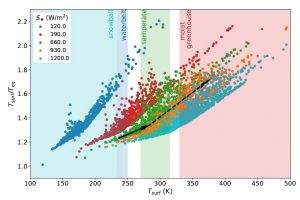Atmosphere and habitability in terrestrial planets. The study: “A systematic study of CO2 planetary atmospheres and their link to the stellar environment” of A. Petralia (INAF-OAPA) recently appeared on MNRAS

Terrestrial planets are common in the Milky Way. It has been estimated, in fact, that at least 30% of stars in the Solar neighborhood host a terrestrial planet, and this fraction increases to 40% considering the habitable zone around all M stars (e.g. stars with effective temperature between 2400 and 3700 degrees) of the Galaxy. The habitable zone is defined as the region around stars where terrestrial planets have the required surface temperature to host liquid water.
It can seem too simplistic to restrict the conditions for the habitability of planets to their distances from their central stars. In fact, the possibility of having liquid water on the surface of a planet depends over several conditions, such as the atmospheric pressure gradient and the presence of chemical elements that can induce the greenhouse effect. Thus, in order to constrain better the conditions at which planets can host liquid water, it is necessary to model their atmospheres in details. This is however a difficult problem, where several variables and processes must be taken into account, such as the energy deposited by the incident stellar radiation, the chemical composition of the atmosphere, the energy transport by convection, clouds, humidity, and the geological and biological processes on the surface. However, the problem can be simplified by approximating the atmosphere to a system with plane-parallel geometry. In this way, in fact, the only important variable is the altitude, and the problem becomes one-dimensional. In these models, thus, the atmosphere is approximated to “infinite vertical air columns”, where thermal equilibrium is set by convection and radiative transfer (accounting for stellar radiation, the thermal emission of the atmosphere, and scattered light, R-C models, radiative-convective).
Handling simplified problems allows the researchers to produce a high number of models exploring the space parameters in an extensive way. This is the method adopted by the team led by the astronomer A. Petralia, INAF – Astronomical Observatory of Palermo, to study the atmospheres of terrestrial planets, connect their properties to the environment, and study their habitability. The team has developed and exploited 6250 models of planetary CO2 atmospheres, varying several parameters such as the flux of stellar energy incident on the atmosphere (considering main sequence stars with spectral classes between F and K, e.g. effective temperatures between 2400 and 7400 degrees) and the concentration of CO2, adopting the method of R-C models. Several properties of the simulated atmospheres critically depend on these two parameters, such as the dilution of CO2. The exploration of such an intensive set of models has also allowed the astronomers to better analyse the condition at which water can be liquid in the surface, finding that most of half of the planets meet the conditions for habitability. The results of this study are described in the paper: “A systematic study of CO2 planetary atmospheres and their link to the stellar environment“, recently appeared on the journal Monthly Notices of the Royal Astronomical Society. Among the authors, the astronomers D. Locci, C. Cecchi-Pestellini, G. Micela and A. Ciaravella of INAF-Astronomical Observatory of Palermo, together with astronomers of the observatories of Padua and Cagliari.
The figure shows the scatter plot of the ratio between the surface temperature over the atmospheric equilibrium temperature (e.g. the temperature of a black body in equilibrium with the incident stellar radiation flux) as a function of the surface temperature. The models are marked with different colors according the intensity of the incident stellar radiation. The plot is divided into regions populated by planets where water exists in different conditions. It is evident that, in a large fraction of the studied models, water can be in liquid state on the planet surface.
Mario Giuseppe Guarcello ( follow mguarce)
